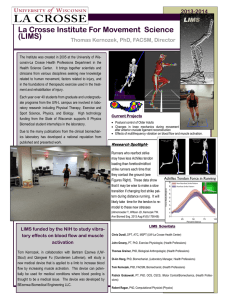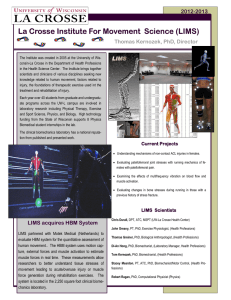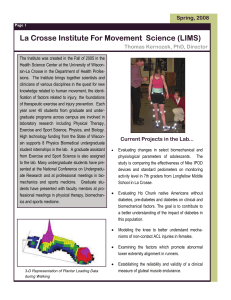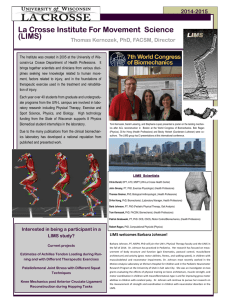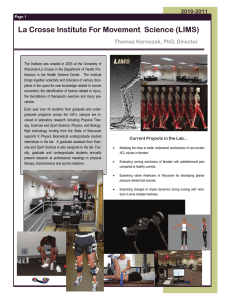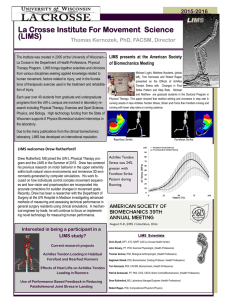La Crosse Institute For Movement Science (LIMS) 2009-2010
advertisement
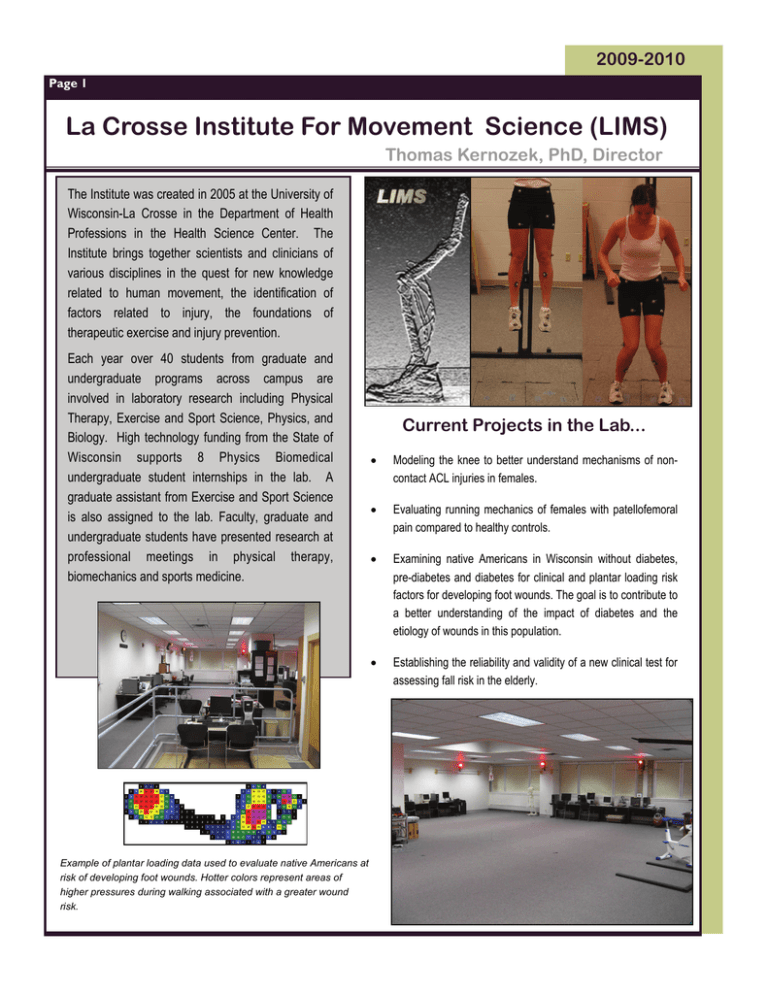
2009-2010 Page 1 La Crosse Institute For Movement Science (LIMS) Thomas Kernozek, PhD, Director The Institute was created in 2005 at the University of Wisconsin-La Crosse in the Department of Health Professions in the Health Science Center. The Institute brings together scientists and clinicians of various disciplines in the quest for new knowledge related to human movement, the identification of factors related to injury, the foundations of therapeutic exercise and injury prevention. Each year over 40 students from graduate and undergraduate programs across campus are involved in laboratory research including Physical Therapy, Exercise and Sport Science, Physics, and Biology. High technology funding from the State of Wisconsin supports 8 Physics Biomedical undergraduate student internships in the lab. A graduate assistant from Exercise and Sport Science is also assigned to the lab. Faculty, graduate and undergraduate students have presented research at professional meetings in physical therapy, biomechanics and sports medicine. Example of plantar loading data used to evaluate native Americans at risk of developing foot wounds. Hotter colors represent areas of higher pressures during walking associated with a greater wound risk. Current Projects in the Lab... • Modeling the knee to better understand mechanisms of noncontact ACL injuries in females. • Evaluating running mechanics of females with patellofemoral pain compared to healthy controls. • Examining native Americans in Wisconsin without diabetes, pre-diabetes and diabetes for clinical and plantar loading risk factors for developing foot wounds. The goal is to contribute to a better understanding of the impact of diabetes and the etiology of wounds in this population. • Establishing the reliability and validity of a new clinical test for assessing fall risk in the elderly. Page 2 2009-2010 LIMS Lab Facilities LIMS labs in the Health Science Center include the 1,800 square foot biomechanics and 1,900 square foot exercise physiology laboratory. The biomechanics laboratory includes an 8 camera motion analysis system and three force platforms, electromyography, seating, barefoot and in-shoe pressure measurement technology, an isokinetic machine and an electromagnetic tracking system. The exercise physiology laboratory includes metabolic and gas analysis systems for bike or treadmill use. 2nd. LIMS Distinguished Lecturer In the Spring of 2009, LIMS hosted their second distinguished lecturer Marjorie Woollacott, PhD from University of Oregon Institute for Neurscience. Dr. Woollacott presented on her research related to fall prevention and the maintenance of postural control in the elderly to faculty, area clinical staff and students. Marjorie Woollacott’s presentation to UW-L Health Professions faculty and students. LIMS Scientists Hanni Cowley, MSPT (Gundersen Lutheran Sports Medicine) Chris Durall, DPT,LIMS ATC, Scientists MSPT (UW-La Crosse Health Center) Hanni Cowley, MSPT (Gundersen Lutheran Sports Medicine) John Greany, PT, PhD, Exercise Physiologist, Chris Durall, DPT, ATC, MSPT (UW-La Crosse Health Center) (Health Professions) John Greany, PT, PhD, Exercise Physiologist, (Health Professions) Thomas Greiner, PhD, Biological Anthropologist, Thomas Greiner, PhD, Biological Anthropologist, (Health Professions) (Health Professions) Di-An Hong, PhD, Biomechanist, (Laboratory Manager, Health Di-An Hong, PhD, Biomechanist, (Laboratory Professions) Manager, Health Professions) Tom Kernozek, PhD, Biomechanist, (Health Professions) Tom Kernozek, PhD, Biomechanist, (Health Stacey Meardon, PT, ATC, PhD, Biomechanist/Motor Control, (Health Professions) Professions) Robert Ragan, PhD, Computational Physicist Robert Ragan, PhD, Computational Physicist (Physics) (Physics) John Willson, MSPT, PhD, Biomechanist, (Health Professions) John Willson, MSPT, PhD, Biomechanist, (Health Professions) New LIMS Scientists inLIMS 2007in 2009 New Scientist joins Di-Ann PhDPT,comes to UW-L StaceyHong, Meardon, ATC, PhD comesfrom to UW-La Crosse Labs Physical Therapy Program LIMS. Stacey Motorola in Schaumburg, IL. and He initiated recently completed her PhD in Kinesiology and managed the biomechatronics researchat the Iowa State University in Biomechanics where she program Motorola Loading for a number of years. He for studiedat “Skeletal and the implications hasstress experience manyhasadvanced fractures”.in She contributedmotion to several publications in refereed motor journalscontrol and presentations analysis technologies, and related to running biomechanics and bone health at biomechanics. various national and international conferences. Dr. Meardon completed MS UW-L degreephysical in Physical John Willson, PhD is aher former Therapy from Washington University in therapy graduate student who completed hisSaint PhD Louis her Biology and Athletic degree in and Movement Science at the Training University of from Wartburg College in Iowa. She served from Delaware in 2007. He is now an assistant2008 to presentin as instructor in the Physical Therapy professor the an Physical Therapy Program. Program at Des Moines University. Page 3 2009-2010 Q&A with John Willson on Painin Taipei, Taiwan Dr. Tom Kernozek is aPatellofemoral Keynote Speaker Wallace, B.J., Kernozek, T.W., Mikat, R.P., Wright, G.A., Simons, What is it? S.Z., Wallace, K.L. (in press). A comparison between back squat exercise and vertical kinematics: Implications forcondition assessing resulting ACL Patellofemoral painjump (PFPS) is a very common in diffuse anterior knee pain that is aggravated by injury risk.ascending Journal of Strength and Conditioning Research running, and descending stairs, and prolonged sitting. The most typical person to experience PFPS is an active, young athlete who participates in sports that require squatting, running, and jumping. Being female also increases the likelihood of developing PFPS nearly twofold. M. (in press). Kernozek, T.W., Durall, C., Friske, A., Mussallem, Ankle bracing and plantar flexion angle does not influence ankle during inversion stress in healthy subjects. Journal of Athletic Training. What it? musclecauses latencies There are many possible causes for PFPS. Abnormal movement of the patella relative to the femur is the most commonly reported mechanism. However, this abnormal patellar movement may be due to altered foot, knee, or hip function. At the Kernozek, T.W., Greany, J.F., Anderson, D., Van Heel, D., foot, many researchers believe that excessive or prolonged pronation may contribute to PFPS by increasing tibial and Youngdahl, R.L., Benesh, Durall, C. (in press).activities. The effect ofHowever, a consistent link between abnormal foot motion and femoral internal rotation B.G. during weight bearing immersion cryotherapy on medial-lateral postural sway in individuals increased tibial or femoral motion thought to cause PFPS has not been consistently identified. At the knee, delayed or with a lateralactivation ankle sprain. diminished of muscles that pull the patella medially during weight bearing activities (vastus medialis) may contribute to PFPS. Individuals that have large patellae or patellae that lie particularly far from the center of the knee joint may also be at risk. Recent studies of the cause of PFPS focus on the role of certain hip muscles to prevent potentially harmful knee motion. Individuals with decreased strength of these hip muscles may be more likely to develop PFPS. How is it treated? Treatment for PFPS begins with minimizing participation in activities known to exacerbate symptoms. Additional interventions should depend on the nature of the causative factors identified during a thorough physical examination. Unfortunately, few common interventions have been rigorously studied. For example, limited evidence exists supporting the use of foot orthotics to minimize increased pronation or hip strengthening exercises to minimize altered knee motion during weight bearing activities. Patellar taping or braces to minimize abnormal patellar movement may also be used for PFPS although consistent positive effects of these interventions have not been identified. To date, the strongest evidence for effective PFPS treatment supports quadriceps strengthening with or without exercises specific to the vastus medialis. Recent Contracts Awarded to LIMS Reebok International Ltd. (Advanced Concepts Division) has provided funding to LIMS to evaluate in-shoe plantar loading with 4 different athletic shoe designs during walking, running and cutting. Funding helps support current and future investigations by the LIMS researchers. Participant shown while running with sensors inside of the athletic shoes being tested. Cybex International Incorporated has funded a project to evaluate the potential differences in lower limb muscle activity and knee joint mechanics with different elliptical exercise machines. This project is on-going through the fall term. Two elliptical machines being evaluated by LIMS researchers. Reflective markers allow cameras to measure movement by cameras. A pedal is instrumented with a force platform Page 4 2009-2010 Recent Publications Lawrence, RK., Kernozek, TW, Miller, EJ., Torry, MR., Reuteman, P. (2008). Influences of hip external rotation strength on knee mechanics during single-leg drop landings in females. Clinical Biomechanics (Bristol, Avon), 23: 806-813. Smith, JP, Kernozek, TW, Kline, DE, Wright, GA. (in press) Kinematic and kinetic variations between three depth jump conditions in male ncaa division III athletes. Journal of Strength and Conditioning Research. Chan, M. Huang, C. Chang, J, Kernozek, TW. (in press). Kinematics and kinetics of the knee and hip position of female basketball players during side-step cutting with and without dribbling. Journal of Medical and Biological Engineering. Ball, KA., Greiner, TM. (2008). On the problems of describing joint axis alignment. Journal of Biomechanics. 41: 1599-603. Willson, JD, Davis IS (2009). Lower extremity strength and mechanics during jumping in females with patellofemoral pain. Journal of Sport Rehabilitation. 18: 76-90. Kernozek, TW., Torry, M., Iwasaki, M. (2008). Effects of gender and neuromuscular fatigue on landing mechanics. The American Journal of Sports Medicine, 36(3): 554-565. Greiner, TM, Ball, KA (2009). Statistical analysis of the three dimensional joint complex. Computer methods in Biomechanics and Biomedical Engineering. 12: 185-195. Willson, JD, Davis, IS. (2008). Lower extremity mechanics of females with and without patellofemoral pain across activities with progressively greater task demands. Clinical Biomechanics (Bristol, Avon), 23(2): 203211. Greiner, TM. (2008). An additional flexor of the fifth digit: Flexor digiti minimi longus. Clinical Anatomy. 12:792-793. Kernozek, TW, Ragan R. (2008) Estimation of anterior cruciate ligament tension from inverse dynamics data and electromyography in females during drop landing. Clinical Biomechanics. 23:1279-1286. Kernozek, TW, Durall, C, Friske, A, Mussallem, M. (2008). Ankle bracing and plantar flexion angle does not influence ankle muscle latencies during inversion stress in healthy subjects. Journal of Athletic Training. 43(1): 37-43. Willson JD, Davis IS. (2008) Utility of the frontal plane projection angle in females with patellofemoral pain. Journal or Orthopaedic and Sports Physical Therapy. 38: 606-616. Fater, DCW, Kernozek TW (2008) Comparison of cervical vertebral separation in supine and seated positions using home traction units. Physiotherapy Theory and Practice. 24: 430-436. Willson JD, Binder-Macleod S, Davis IS. (2008). Lower Extremity Jumping Mechanics of Female Athletes With and Without Patellofemoral Pain Before and After Exertion. American Journal of Sports Medicine. 36:158796. Heinert, B, Kernozek, TW, Greany, JF, Fater, DCW. (2008). The effect of hip abductor weakness on lower extremity kinematics during the stance phase of running in healthy females. Journal of Sport Rehabilitation. 17: 243-256. Kernozek, TW, Greany, JF, Durall, C. Anderson, D. Van Heel, R. Youngdahl, D, Benesh, B. (2008). Effects of cryotherapy on postural sway variability on participants after a lateral ankle sprain. Physiotherapy Research International. Jun;13(2):107-18. For more Information about LIMS, contact: Wallace, BJ, Kernozek, TW, Mikat, RP, Wright, GA, Simons, SZ, Wallace, KL. (2008). A comparison between back squat exercise and vertical jump kinematics: Implications for assessing acl injury risk. Journal of Strength and Conditioning Research. 23: 803-813. Dr. Tom Kernozek, Director of LIMS 4070 Health Science Center University of Wisconsin—La Crosse 1725 State Street La Crosse, WI 54601 608-785-8468 http://perth.uwlax.edu/pt/LIMS.htm

